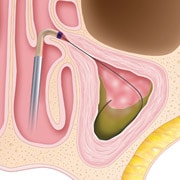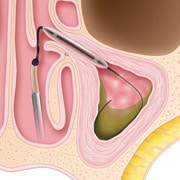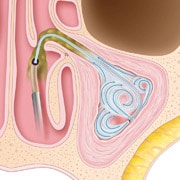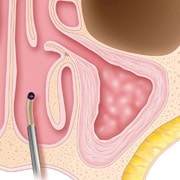Balloon Sinuplasty
What is Balloon Sinuplasty™?
The painful symptoms associated with chronic sinusitis can be overwhelming. If symptoms are difficult to control with medications alone, your primary doctor may refer you to an Ear, Nose and Throat (ENT) specialist, who can determine the best course of treatment, including further medication therapy or surgery to open the sinus passage ways.
Now, there is an additional surgical option for treatment of blocked sinuses called Balloon Sinuplasty™ technology. If you have been diagnosed with chronic sinusitis and are not responding well to antibiotics you may be a candidate for surgery, you now have a less invasive option that is clinically proven to be safe, effective and improve the quality of your life.
Balloon Sinuplasty™ technology is an endoscopic, catheter-based system for patients suffering from sinusitis. The FDA-cleared technology uses a small, flexible, sinus balloon catheter to open up blocked sinus passageways, restoring normal sinus drainage. When the sinus balloon is inflated, it gently restructures and widens the walls of the passageway while maintaining the integrity of the sinus lining.

Step 1. A balloon catheter is inserted into the inflamed sinus.

Step 2. The balloon is inflated to expand the sinus opening.

Step 3. Saline is sprayed into the inflamed sinus to flush out the pus and mucus.

Step 4. The system is removed, leaving the sinuses open.
Balloon Sinuplasty™ Video
Balloon Sinuplasty™ Benefits
The benefits of Balloon Sinuplasty™ technology for treating chronic sinusitis symptoms include:
- Safe and Effective While use of any surgical instrument involves some risk, clinical research has indicated the Balloon Sinuplasty™ system to be safe and effective in relieving symptoms of sinusitis.
- Minimally Invasive The technology uses small, soft, flexible devices that enter entirely through the nostrils. These devices gently open blocked sinus openings, and in many cases, without tissue or bone removal.
- Reduced Bleeding Because in many instances no tissue or bone is removed when using this technology, there may be reduced bleeding associated with the procedure.
- Improved Recovery Time While recovery time varies with each patient, many people can return to normal activities within 24 hours.
- Does Not Limit Treatment Options This technology is an endoscopic tool and may be used with other medical therapies or sinus surgery techniques. It does not limit future treatment options if you have progressive disease.
Frequently Asked Questions
What is sinusitis?
Sinusitis is an inflammation of the sinus lining. If the sinus opening becomes swollen shut, normal mucus drainage may not occur, and this may lead to infection and inflammation of the sinuses.
What are the common symptoms of sinusitis?
Common symptoms include:
- Facial pain, pressure, congestion or fullness
- Difficulty breathing through the nose
- Discharge of yellow or green mucus from the nose
- Teeth pain
- Loss of the sense of smell or taste
- Headache
- Fatigue
- Sore throat
- Bad breath
What types of doctors treat sinusitis?
Many types of doctors treat sinusitis, including general and family practice physicians, pediatricians, and allergists. However, if you have chronic sinusitis or do not respond to medical treatment, you may be referred to a specialist – an Ear, Nose, and Throat (ENT) physician, or Otolaryngologist.
How is sinusitis treated?
Three approaches have emerged for treating sinusitis patients:
- Medical therapy
- Endoscopic sinus surgery with cutting instruments
- Endoscopic sinus surgery with balloon catheters
Medical Therapy
Sinusitis is typically treated first with medication. Treatment with antibiotics or topical nasal steroid sprays is successful for many sinusitis sufferers. Inhaling steam or use of saline nasal sprays or drops can also help. However, at least 20% of patients do not respond adequately to medications.
Endoscopic Sinus Surgery (with cutting instruments)
Sinus surgery aims to clear blocked sinuses and restore normal sinus drainage. The procedure removes bone and tissue to enlarge the sinus opening. The removal of bone and tissue may lead to pain, scarring, and bleeding.
Endoscopic Sinus Surgery (with Balloon Sinuplasty™ technology)
The technology utilizes a small, flexible, Sinus Balloon that is placed into the nose to reach the sinuses. The Sinus Balloon is gradually inflated to gently restructure the previously blocked sinus opening which helps to restore normal sinus drainage and function. There is minimal bleeding, and many patients have been able to return to normal activities within 24 hours. Clinical research has indicated that the Balloon Sinuplasty™ system is a safe and effective instrument in dilating blocked sinuses.
What is the Balloon Sinuplasty™ system?
The Balloon Sinuplasty™ system is the name used for a group of medical devices that are used to create openings in your sinuses. The devices use a small, flexible balloon that is placed into the nose to reach the sinuses. The balloon is gradually inflated to gently restructure the previously blocked nasal passage, restoring normal sinus drainage.
What are the Balloon Sinuplasty™ devices?
The Balloon Sinuplasty™ devices are FDA-cleared, endoscopic, catheter-based instruments specifically designed to be used in sinus surgery. The Sinus Balloon Catheter is gradually inflated to gently restructure the previously blocked sinus opening, which restores normal sinus drainage, without damaging the sinus.
Does surgery with the Balloon Sinuplasty™ technology work?
Clinical research has indicated that using Balloon Sinuplasty™ technology is safe and effective in dilating sinus openings.
How long does symptom relief last after surgery with Balloon Sinuplasty™ technology?
Results vary by individual. Published clinical data has shown the following regarding patients who have had sinus surgery with Balloon Sinuplasty™ technology:
- A study of 1,036 patients at multiple institutions reported that sinus symptoms improved in 96% of patients at an average follow-up period of 10 months.
- Another study followed 65 patients at multiple institutions and reported clinically and statistically significant improvement in patient symptoms out to 2 years.
How do sinus openings stay open after surgery with Balloon Sinuplasty™ technology?
Balloon Sinuplasty™ technology dilates sinus openings, or ostia by pushing aside bones which comprise the sinus ostia. Moving bone remodels the sinus ostis, creating wider openings.
Are the Balloon Sinuplasty™ devices safe?
The Balloon Sinuplasty™ technology is minimally invasive and has been clinically demonstrated to be safe by leading Ear, Nose and Throat doctors. Finally, unlike other surgical methods used to clear blocked sinus openings, Balloon Sinuplasty™ technology does not remove any bone or tissue and some patients return to normal activities quicker – within 24 hours without other co-morbid conditions.
What are the risks of surgery with Balloon Sinuplasty™ technology?
Your healthcare provider can best explain the potential risks of surgery with Balloon Sinuplasty™ technology. In all published clinical data, no serious adverse events attributable to the Balloon Sinuplasty™ system have been reported.
How long does surgery with Balloon Sinuplasty™ technology take?
The duration of the procedure varies by individual situations. Ask your healthcare provider for the most accurate answer.
In a study of 1,036 patients who underwent sinus surgery with Balloon Sinuplasty™ technology at multiple institutions, an average procedure time was 3 hours, including the surgery and post-anexthesia recovery time. None of the patient required an overnight stay at the hospital.
Will I require general anesthesia for surgery with Balloon Sinuplasty™ technology?
Most patients undergo general anesthesia for sinus surgery with Balloon Sinuplasty™ technology, but some patient have had the procedure under local anesthesia. Your healthcare provider can best advise you on your anesthesia options.
How long does it take to recover from a typical surgery using the Balloon Sinuplasty™ system?
Because the system is minimally invasive it is typically used in an outpatient setting. While recovery time will vary from patient to patient, many people can return to normal activities within 24 hours after surgery.
Does surgery with Balloon Sinuplasty™ devices limit my treatment options?
No. Balloon Sinuplasty™ devices are endoscopic tools used within conventional sinus surgery and may be used with other medical therapies. They do not limit future treatment options for patients.
Are Balloon Sinuplasty™ devices right for me?
If you suffer from sinusitis, and medication alone has not been effective in relieving your symptoms, you may be a candidate for surgery using the Balloon Sinuplasty™ devices. To find out if you are a candidate for the Balloon Sinuplasty™ devices, click here. We also encourage you to talk to your doctor about whether use of these FDA-cleared, endoscopic, catheter-based tools is right for you.
Who uses Balloon Sinuplasty™ devices?
Ear, Nose, and Throat physicians who have been trained on the Relieva Balloon Sinuplasty™ devices.
Are Balloon Sinuplasty™ devices covered by Medicare?
Yes. Medicare covers Balloon Sinuplasty™ devices.
Are Balloon Sinuplasty™ devices covered by other insurance carriers?
Most insurance companies cover sinus surgery with Balloon Sinuplasty™ devices. To be certain of your coverage, contact your insurance provider to find out your specific coverage policy.
Call ENT & Allergy Specialists – Ear Nose and Throat Physicians and Surgeons at (859) 781-4900 for more information or to schedule an appointment.